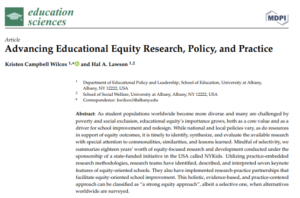Advancing Educational Equity Research, Policy, and Practice: Reflections on 18 Years of NYKids Research
By Kristen C. Wilcox & Hal A. Lawson
Unpacking “Equity”
“Equity continues to be defined in a variety of ways and the goals and character of equity-oriented improvement efforts are impacted by how equity is defined” (Wilcox & Lawson, 2022, p. 13).
As we discuss in our article “Advancing educational equity, research, policy, and practice”, educational equity, operationalized as fair and just treatment of every student, is a core value, a policy priority, a key standard for pedagogical practices, and a prized outcome in new school designs worldwide.
While equity-focused policy and practice have been mainstays in some nations, the current impetus can be attributed to massive migration patterns and nation-specific immigration policies.
Two related descriptors are employed to describe equity-focused priorities for responding to, and anticipating, growing ethnic, cultural, linguistic, identity-related, and socio-economic diversity.
- Salient policies, practices, and innovative school designs aim to prevent social exclusion while facilitating students’ social inclusion.
- Beyond these generic features, enduring priorities worldwide start with the educational success of the greatest number of students—no matter what their background and characteristics—and with special attention to priority outcomes, some nearly universal (e.g., as measured on PISA tests) and others nation-specific.
 Educational equity should not be conflated with equality. Equity emphasizes:
Educational equity should not be conflated with equality. Equity emphasizes:
- special policies,
- customized practices, and
- non-discriminatory, personalized treatment.
Equality, on the other hand, means “sameness” achieved by standardization.
This distinction is consequential for policy, practice, research and evaluation, and organizational designs for schools and other educational organizations. Unfortunately, equity and equality sometimes are viewed as synonyms and, when they are, improvement initiatives tend to be side-tracked and fall short of their potential.
NYKids: Looking for Equity in All the Right Places
While RPP (research-practice-partnership)-structured mechanisms for research communications and dissemination are essential, they do not ensure utilization in service of equity ideals. Practice-embedded, school-specific frameworks are needed (Wilcox & Lawson, 2022, p. 13).
While variability among and within nations is normative, four equity-related commonalities and similarities derive from world-wide reviews:
(1) gender equity with special emphasis on girls and students self-identifying as gay, lesbian, bisexual, and transgender;
(2) diverse students’ social inclusion via varying combinations of cultural assimilation and accommodation;
(3) students’ preparation for workforce roles as adults; and
(4) students’ readiness to participate in and contribute to their host society’s political, economic, and social institutions.
 In many nations, the grand transition away from schools founded on equality values and toward new designs founded on equity includes a policy imperative. New designs for equity should be theoretically sound, research-informed, data-driven, and positioned for organizational learning and continuous improvement.
In many nations, the grand transition away from schools founded on equality values and toward new designs founded on equity includes a policy imperative. New designs for equity should be theoretically sound, research-informed, data-driven, and positioned for organizational learning and continuous improvement.
These requirements implicate a practical question of worldwide significance: what is the state of knowledge regarding schools that prize, make progress toward, and achieve equity? This question guided Wilcox and Lawson as they reviewed NY Kids research.
We found that positive outlier schools shared the following priorities and qualities:
- Culturally responsive and sustaining instructional core;
- Distributed, adaptive, and trust-building leadership facilitated by effective communications;
- Inclusive school cultures and welcoming climates;
- Data monitoring systems and evidence-guided decision-making;
- School-community connections;
- Holistic youth development;
- Capacity-building for an improvement-oriented learning organization.
Many of these findings, alone and together, align with the research on effective schools. However, NYKids researchers have gone beyond the effective school research. They have sought to move the research and development agenda from purely description to explanation of how equity-oriented schools, serving demographically diverse communities from small rural to urban, develop their characteristic features and organizational designs. What is more, NYKids researchers have gone beyond research on schools to research with and for school and district leaders and educators seeking to improve. These research-partnership initiatives have been guided by improvement-science and other participatory research designs.
The NYKids research and development strategy can be classified and described as a practice-forward approach, and it contrasts with research limited to social analysis. Our practice forward strategy aligns with the needs of our K-12 partners and offers the potential for the simultaneous renewal of schools and university-based educator preparation programs.
To read more please check out our open access article: Advancing Educational Equity Research, Policy, and Practice
A Coda
As NYKids prepares for a roughly two-week “winter’s nap” (we will be back to our blogs the week of January 9th), we wish you and yours a safe and joyful holiday season.
Thank you for your interest in NYKids! We invite you to follow us on Twitter, Instagram, or Facebook, for announcements and encourage you to reach out to nykids@albany.edu if you have any questions, feedback, or interest in continuous improvement support.
